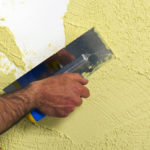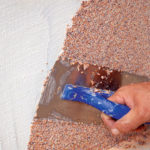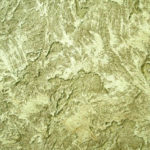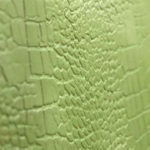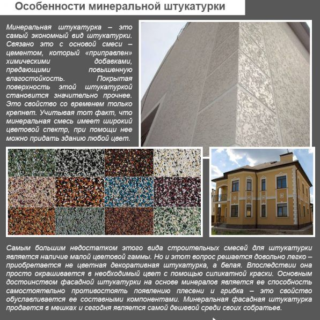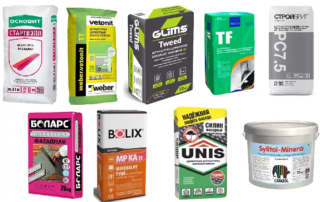Facade plastering is one of the most popular methods for exterior decoration of private houses. Many property owners in vain consider this option outdated and does not correspond to modern design. Decorative plaster for external finishing of facades is not inferior in almost all respects to such materials as stone, porcelain stoneware and siding. This type of cladding combines many positive characteristics. One of them is the ability to plaster the house with your own hands, saving a considerable amount on the payment of hired workers.
Varieties of facade plaster
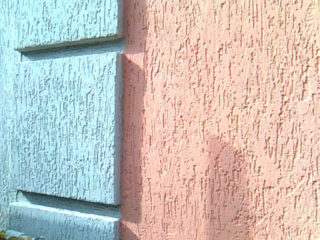
Plastering of the external surfaces of buildings is carried out in order to protect the bearing surfaces from the influence of the environment, to give the house a presentable look and to isolate it from the effects of extremely high and low temperatures. When planning work, you should take into account a number of related factors: climate, location and characteristics of the structure itself.
Today, the following types of facade plaster for outdoor use are on sale:
- Mineral. The mixture is based on cement. This determines the high strength and affordable cost of the material. Most of the powder is neutral gray in color. Decorating is carried out by adding dyes and other fillers. Another option is to paint the dried surface with facade paints. The quality of the mortar is determined by the brand of cement.
- Acrylic. The product is made from polymer resins, which are a by-product of the petrochemical industry. This factor has a positive effect on its price, while the quality of the coating is quite decent. Plaster has excellent waterproofing properties, it is more often used for finishing concrete walls, where ventilation properties are not required.
- Silicate. The composition is based on liquid glass. The material has a high permeability into porous surfaces, it is an excellent solution for finishing aerated concrete walls with hygroscopicity. The plasticity of the mixture makes it possible to process both smooth and geometrically complex shapes. The product is sold in an already specified color or fillers are added to the taste of the property owner. After the solution has dried, additional processing is not required.
- Silicone. It is the most expensive, but the most effective finishing material for outdoor work. The finished coating combines waterproofing and ventilation properties. Resistant to UV light, chemicals and temperature extremes. The color is very stable, does not lose its saturation throughout the entire period of operation.
In addition to the protective and decorative function, the plaster facade can perform the tasks of insulating buildings. Modern technologies make it possible to create layers up to 5 cm thick, which in their properties are not inferior to the "wet facade".
Features of materials and their characteristics
Pay attention to the following performance characteristics of the plaster:
- Life time.You should purchase products that have a warranty of at least 25 years.
- Water vapor permeability. This indicator is taken into account when walls are decorated with ventilation properties. These include buildings made of laminated veneer lumber and aerated blocks. It can be neglected when working with bricks and concrete.
- UV resistant. If not, the material fades, becomes brittle and loses its performance characteristics.
- Degree of adhesion to supporting surfaces. The higher it is, the less likely the coating will peel off.
- Price. Experts recommend considering this factor last. Poor quality materials are of low cost, but also short-lived.
- Material consumption. This indicator directly affects the amount of work and the cost of construction. It is necessary to objectively assess your ability to apply layers of solution of different thicknesses.
By comparing all the criteria, you can make a choice and make purchases. However, purchasing a quality product is not enough. It is necessary to use it correctly and correctly.
Surface preparation for outdoor use
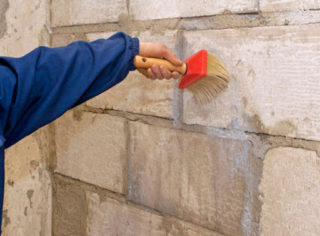
Wall preparation consists of the following steps:
- Checking the geometry of the walls using a tape measure, a plumb line and a rule.
- Removing design elements and protruding and unstable fragments.
- Surface treatment with deep penetration primer. This strengthens the substrate and improves its adhesion.
- Align the grooves. A cement mortar is used, applied with a spatula. If the wall is curved, the differences are eliminated by the rule.
- Re-treatment of the material applied during leveling with a deep penetration primer.
In conclusion, the installation of beacons is carried out. They are placed at a distance of 20 cm from the bottom and top of the wall at a level corresponding to the thickness of the layer. The optimal solution is to use stainless steel products.
The main advantages of facade plaster
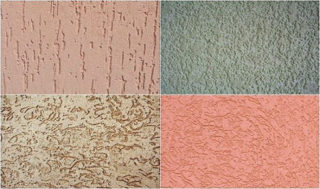
Facade plaster has a long history of use in private and industrial construction. The material has proven itself to be excellent for finishing surfaces of any composition and configuration.
The main advantages of various types of mixtures:
- The ability to apply on surfaces of the most complex shape. The solution exactly follows the configuration of the structure, keeping its original contours.
- Long service life. After finishing with a high-quality composition and in accordance with technology, you can forget about repairs for decades.
- Ease of application. No complicated and expensive equipment is required. A set of ordinary hand tools that are in every home is enough.
- Thermal insulation properties. Warm plaster for the facade protects the building from heat and cold no worse than 5 cm thick foam.
- Waterproof. The mixture does not include gypsum, only components are used that crystallize after solidification and do not absorb moisture.
- Environmental Safety. World-renowned manufacturers do not use substances harmful to humans and nature. They are absent during mixing, hardening and heating.
- Refractoriness. A layer of plaster is an effective protection against the spread of fire from the outside and from the inside.
- Attractive appearance. Surfaces can be given glossy, matte and textured textures. There are technologies for manufacturing surfaces such as Bark beetle, Boulder, Lamb and Shuba.
A creative approach to business allows you to create a presentable and practical surface that will decorate, protect and delight its owners for decades.
Installation technology
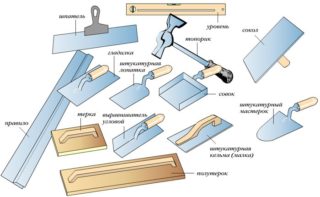
One of the conditions for decorating a house with plaster is dry weather and the absence of strong winds. Work can be carried out even at sub-zero temperatures if antifreeze is added to the solution.
For installation, you will need the following tools:
- puncher;
- a hammer;
- screwdriver;
- rule;
- plumb line;
- roulette;
- spatulas;
- Master OK;
- paint brush;
- grater.
The work is carried out in the following sequence:
- Checking the readiness of tools, equipment and materials. Laying film, cardboard or plywood to protect the area from contamination.
- Mixing the solution. The proportions of water and mixture are taken in accordance with the manufacturer's instructions. Usually the powder is poured into water while stirring with a mixer. The mixture is allowed to stand and then mixed again.
- Throwing plaster on the wall. This is done from the bottom up in a strip up to one meter high.
- Smoothing the solution, removing excess, adding them to the container for later use.
- Repeat the procedure until you reach the top of the wall.
- Leveling the surface with a wide trowel and float.
The final phase is to give the finish the desired texture and color.
Famous brands of facade plaster
- Osnovit;
- Weber-Vetonit;
- Glims;
- Kiilto;
- Stroybrig;
- Bolars;
- Bolix;
- Knauf;
- Unis.
The products are characterized by high performance and durability.
When buying, you should check the certificate of conformity for the product. It is not recommended to purchase plaster in the markets, it is better to do this in branded retail outlets.

